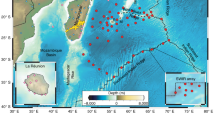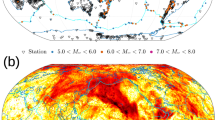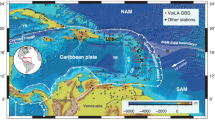Abstract
The origin of the Yellowstone and Snake River Plain volcanism has been strongly debated. The mantle plume model successfully explains the age-progressive volcanic track, but a deep plume structure has been absent in seismic imaging. Here I apply diffractional tomography to receiver functions recorded at USArray stations to map high-resolution topography of mantle transition-zone discontinuities. The images reveal a trail of anomalies that closely follow the surface hotspot track and correlate well with a seismic wave-speed gap in the subducting Farallon slab. This observation contradicts the plume model, which requires anomalies in the mid mantle to be confined in a narrow region directly beneath the present-day Yellowstone caldera. I propose an alternative interpretation of the Yellowstone volcanism. About 16 million years ago, a section of young slab that had broken off from a subducted spreading centre in the mantle first penetrated the 660 km discontinuity beneath Oregon and Idaho, and pulled down older stagnant slab. Slab tearing occurred along pre-existing fracture zones and propagated northeastward. This reversed-polarity subduction generated passive upwellings from the lower mantle, which ascended through a water-rich mantle transition zone to produce melting and age-progressive volcanism.
This is a preview of subscription content, access via your institution
Access options
Access Nature and 54 other Nature Portfolio journals
Get Nature+, our best-value online-access subscription
$29.99 / 30 days
cancel any time
Subscribe to this journal
Receive 12 print issues and online access
$259.00 per year
only $21.58 per issue
Buy this article
- Purchase on Springer Link
- Instant access to full article PDF
Prices may be subject to local taxes which are calculated during checkout






Similar content being viewed by others
References
Morgan, W. J. Deep mantle convection plumes and plate motions. Bull. Am. Assoc. Pet. Geol. 56, 203–213 (1972).
Christiansen, R. L., Foulger, G. R. & Evans, J. R. Upper-mantle origin of the Yellowstone hotspot. Geol. Soc. Am. Bull. 114, 1245–1256 (2002).
Kincaid, C., Druken, K. A., Griffiths, R. W. & Stegman, D. R. Bifurcation of the Yellowstone plume driven by subduction-induced mantle flow. Nat. Geosci. 6, 395–399 (2013).
Leonard, T. & Liu, L. The role of a mantle plume in the formation of Yellowstone volcanism. Geophys. Res. Lett. 43, 1132–1139 (2016).
Burdick, S. et al. Upper mantle heterogeneity beneath North America from travel time tomography with global and USArray transportable array data. Seismol. Res. Lett. 79, 384–392 (2008).
Schmandt, B. & Humphreys, E. Complex subduction and small-scale convection revealed by body-wave tomography of the western United States upper mantle. Earth. Planet. Sci. Lett. 297, 435–445 (2010).
Sigloch, K., McQuarrie, N. & Nolet, G. Two-stage subduction history under North America inferred from multiple-frequency tomography. Nat. Geosci. 1, 458–462 (2008).
Sigloch, K. Mantle provinces under North America from multifrequency P wave tomography. Geochem. Geophys. Geosyst. 12, Q02W08 (2011).
James, D. E., Fouch, M. J., Carlson, R. W. & Roth, J. B. Slab fragmentation, edge flow and the origin of the Yellowstone hotspot track. Earth. Planet. Sci. Lett. 311, 124–135 (2011).
Tian, Y., Zhou, Y., Sigloch, K., Nolet, G. & Laske, G. Structure of North American mantle constrained by simultaneous inversion of multiple-frequency SH, SS, and Love waves. J. Geophys. Res. 116, B02307 (2011).
Porritt, R. W., Allen, R. M. & Pollitz, F. F. Seismic imaging east of the Rocky Mountains with USArray. Earth. Planet. Sci. Lett. 402, 16–25 (2014).
van der Lee, S. & Nolet, G. Seismic imaging of the subducted trailing fragments of the Farallon plate. Nature 386, 266–269 (1997).
Zhou, Q., Liu, L. & Hu, J. Western US volcanism due to intruding oceanic mantle driven by ancient Farallon slabs. Nat. Geosci. 11, 70–76 (2018).
Cao, A. & Levander, A. High-resolution transition zone structures of the Gorda slab beneath the western United States: implication for deep water subduction. J. Geophys. Res. 115, B07301 (2010).
Schmandt, B., Dueker, K., Humphreys, E. & Hansen, S. Hot mantle upwelling across the 660 beneath Yellowstone. Earth. Planet. Sci. Lett. 331, 224–236 (2012).
Gao, S. S. & Liu, K. H. Mantle transition zone discontinuities beneath the contiguous United States. J. Geophys. Res. Solid Earth 119, 6452–6468 (2014).
Katsura, T. & Ito, E. The system Mg2SiO4–Fe2SiO4 at high pressures and temperatures: precise determination of stabilities of olivine, modified spinel, and spinel. J. Geophys. Res. 94, 15,663–15,670 (1989).
Bina, C. R. & Helffrich, G. Phase transition Clapeyron slopes and transition zone seismic discontinuity topography. J. Geophys. Res. 99, 15,853–15,860 (1994).
Deng, K. & Zhou, Y. Wave diffraction and resolution of mantle transition zone discontinuities in receiver function imaging. Geophys. J. Int. 201, 2008–2025 (2015).
Wortel, M. J. R. & Spakman, W. Subduction and slab detachment in the Mediterranean–Carpathian region. Science 290, 1910–1917 (2000).
Williams, Q. & Hemley, R. Hydrogen in the deep earth. Annu. Rev. Earth. Planet. Sci. 29, 365–418 (2001).
Kohlstedt, D., Keppler, H. & Rubie, D. Solubility of water in the α, β and γ phases of (Mg,Fe)2SiO4. Contrib. Mineral. Petrol. 123, 345–357 (1996).
Murakami, M., Hirose, K., Yurimoto, H., Nakashima, S. & Takafuji, N. Water in Earth’s lower mantle. Science 295, 1885–1887 (2002).
Wang, X.-C., Wilde, S. S., Li, Q.-L. & Yang, Y.-N. Continental flood basalts derived from the hydrous mantle transition zone. Nat. Commun. 6, 7700 (2015).
Wei, S. S. & Shearer, P. M. A sporadic low-velocity layer atop the 410 km discontinuity beneath the Pacific Ocean. J. Geophys. Res. 122, 5144–5149 (2017).
Dickinson, W. R. & Snyder, W. S. Geometry of triple junctions related to San Andreas Transform. J. Geophys. Res. 84, 561–572 (1979).
Thorkelson, D. J. & Taylor, R. P. Cordilleran slab windows. Geology 17, 833–836 (1989).
Wang, Y. et al. Fossil slabs attached to unsubducted fragments of the Farallon plate. Proc. Natl Acad. Sci. USA 110, 5342–5346 (2013).
Piromallo, C., Becker, T. W., Funiciello, F. & Faccenna, C. Three-dimensional instantaneous mantle flow induced by subduction. Geophys. Res. Lett. 33, L08304 (2006).
DeMets, C. & Merkouriev, S. High-resolution reconstructions of Pacific–North America plate motion: 20 Ma to present. Geophys. J. Int. 207, 741–773 (2016).
Goff, J. A. & Cochran, J. R. The Bauer scarp ridge jump: a complex tectonic sequence revealed in satellite altimetry. Earth. Planet. Sci. Lett. 141, 21–33 (1996).
Lynn, W. S. & Lewis, B. T. R. Tectonic evolution of the northern Cocos plate. Geology 4, 718–722 (1976).
Anders, M. H. Constraints on North American plate velocity from the Yellowstone hotspot deformation field. Nature 369, 53–55 (1994).
Muller, R. D. et al. Ocean basin evolution and global-scale plate reorganization events since Pangea breakup. Annu. Rev. Earth. Planet. Sci. 44, 107–138 (2016).
Laske, G., Masters, G., Ma, Z. & Pasyanos, M. Update on CRUST1.0—a 1-degree global model of Earth’s crust. EGU General. Assem. Conf. Abstr. 15, 2658 (2013).
Acknowledgements
This research was supported by the US National Science Foundation under Grants EAR-1737737 and EAR-1348131. Advanced Research Computing at Virginia Tech provided computational resources.
Author information
Authors and Affiliations
Corresponding author
Ethics declarations
Competing interests
The author declares no competing interests.
Additional information
Publisher’s note: Springer Nature remains neutral with regard to jurisdictional claims in published maps and institutional affiliations.
Supplementary information
Supplementary Information
Supplementary Figures
Rights and permissions
About this article
Cite this article
Zhou, Y. Anomalous mantle transition zone beneath the Yellowstone hotspot track. Nature Geosci 11, 449–453 (2018). https://doi.org/10.1038/s41561-018-0126-4
Received:
Accepted:
Published:
Issue Date:
DOI: https://doi.org/10.1038/s41561-018-0126-4
This article is cited by
-
Mechanisms to generate ultrahigh-temperature metamorphism
Nature Reviews Earth & Environment (2023)
-
Progress in the numerical modeling of mantle plumes
Science China Earth Sciences (2023)
-
Ridge subduction, magmatism, and metallogenesis
Science China Earth Sciences (2020)
-
Surface and mantle records reveal an ancient slab tear beneath Gondwana
Scientific Reports (2019)
-
Yellowstone debate erupts again
Nature Geoscience (2018)



